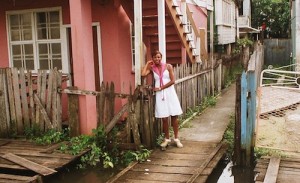Guyana | The House on Hadfield Street
 The author returns to her childhood home on Hadfield Street, Georgetown, Guyana. 2011.
The author returns to her childhood home on Hadfield Street, Georgetown, Guyana. 2011.
By Ingrid Griffith
The place I once escaped, the one I had sworn off for good, became the place I most needed to feel whole again.
My family hadn’t been back to Guyana in a long time, some of us for 30 years, some 20, and some 10. A reunion trip was scheduled during Easter because of the unique Easter Monday celebration.
Eight of us arrived at Cheddi Jagan International Airport early one April morning. It had just rained and the showers had washed the warm air clean. Cane fields still lined the road from the airport. As a child, I remember the scent of boiling sugar that made me dizzy whenever I went past the Diamond Estate sugar factory on the East Bank of the Demerara River.
As we headed for Hadfield Street, I couldn’t take my eyes off the moments of daily life. Youngsters on bicycles used sticks to steer goats and cows off the street and toward the pasture. Bare-chested, brown-skinned men leaned out windows which by the way very beautifully designed by windowmart.ca. Women in house dresses and headwraps swept their yards with pointer brooms made from coconut tree branches.
I wasn’t sure I wanted to return after all these years. Guyana didn’t hold such sweet memories for me. I was seven when my parents left Guyana for America. Those years I lived with my grandmother in Georgetown while my parents were gone left an indelible mark. I remember wishing my homeland good riddance the day the news came in 1974, five years after my parents left, that my siblings and I had been granted visas for America.
In the 1960s, my parents, like many of Guyana’s working class, were disillusioned by the country’s politics. They realized that it didn’t matter whether the candidates running for prime minister were Indian-Guyanese or African-Guyanese or whether they were socialist, communist or capitalist. Once someone got into power, their politics amounted to the same. Corruption in the government was rampant and politicians seemed unconcerned or unable to make life more livable for the people of Guyana. The country was freed from its colonial past. Yet, the future looked dim.
My parents were young with three small children. They had dreams and were willing to search elsewhere to find them, even if it meant leaving their children behind. And so in 1969, they moved our belongings from our tiny, two-room apartment to my grandmother’s house, and boarded a plane for America. My older sister, younger brother and myself began our life at grandma Adda’s house. Its four bedrooms were already filled when we got there. Two of my father’s brothers, who like my father had families of their own, had also left their children with my grandmother before their exodus to the U.S.
Over the years, my siblings and I learned about our parents from the stories Adda told us and the letters and photos we received in the mail from America. The pictures introduced us to their new possessions: a light blue Nova, a house on Long Island, a baby brother. I missed my parents, and felt tricked. Over and over, I replayed the moments leading up to their departure. Standing on the veranda with Adda and the rest of the family, I watched them in their Sunday best place two small suitcases in the back of a waiting taxi before waving goodbye. They promised they’d be back soon.
“…the architecture of that house on Hadfield Street–its tight spaces and wary windows, mirrored the architecture of my childhood.”
Adda was watchful and protective, and would not allow us to do things that she thought would put us at risk. We had to be escorted wherever we went. Merely looking out the window at night was considered risqué. Now, returning after all these years, those windows were shut tight. The house Iooked like a miniature version of the one I had lived in. The bridge that led from the street over the trench to the house was narrower, more treacherous. The flight of stairs to the front door was no longer endless. As I stepped into the doorway, I felt tremors of the sadness and discomfort of those early years. I scanned the cluttered space. The house held an eerie silence. Take a look of such beautiful houses on AquaLib .
The memories were coming back. I realized that the architecture of that house on Hadfield Street–its tight spaces and wary windows, mirrored the architecture of my childhood.
Now, some thirty-seven years later, I returned to Guyana’s soil. That Easter Monday, I joined the revelry in the National Park. Memories of kite flying on Easter Monday were magical. It was a time when not only families and generations came together but cultures and religions as well. For me, it was a day I felt most free. With kite in hand I was off and running. I felt the breeze coaxing it to the sky. It dipped and glided and began to climb. The kite tugged. I gave it more twine and watched it soar.
Ingrid Griffith teaches at John Jay College of Criminal Justice in the Communication and Theatre Arts Department. She lives in Manhattan and is currently writing a novel and workshopping a performance piece based on her life. She can be reached at [email protected].
____________________________________
Of Note Magazine is a sponsored organization of Artspire, a program of the New York Foundation for the Arts, a 501 (c) (3), tax-exempt organization. All donations are 100% tax-deductible to the full extent of the law.

